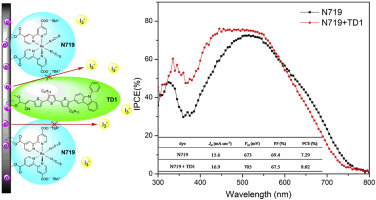Journal of Power Sources ( IF 9.2 ) Pub Date : 2020-01-25 , DOI: 10.1016/j.jpowsour.2020.227776 Zhi-Sheng Wu , Xin-Chao Song , Ya-Dong Liu , Jie Zhang , Hu-Sheng Wang , Zheng-Jian Chen , Shuang Liu , Qiang Weng , Zhong-Wei An , Wang-Jun Guo

|
Three new organic dyes (TD1–TD3) featured with donor–π–acceptor architecture are synthesized and applied to dye-sensitized solar cells (DSSCs). In these sensitizers, an alkyl oligothiophene π-spacer is used to link the 2-cyanoacrylic acid acceptor with varied arylamines donors, i.e. carbazole (TD1), phenothiazine (TD2) or triphenylamine (TD3). The effects of different donor units on the photophysical, electrochemical, and photovoltaic properties of sensitizers are investigated in detail. They all show intensive UV–vis absorption around 400 nm with rod-like molecular structures. The co-sensitizations of TD1–TD3 with ruthenium complex N719 are further evaluated. Consequently, the co-sensitized DSSCs demonstrate superior photovoltaic performances with power conversion efficiencies (PCEs) ranging from 7.60% to 8.02% in relation to the cell with N719 (PCE = 7.29%) alone, which is mainly ascribed to the higher short-circuit photocurrents (Jsc) in combination with larger open-circuit voltages (Voc). Moreover, the origins of these improvements are examined by incident photon to current efficiency (IPCE) spectra and electrochemical impedance spectroscopy (EIS) investigations. The Jsc is improved because TD1–TD3 could compensate for the photocurrent loss induced by I−/I3−; whereas, the Voc is enhanced owing to the fact that the electron recombination process is retarded upon co-sensitization.
中文翻译:

具有多种芳基胺供体的新型有机染料,可作为染料敏化太阳能电池中钌配合物N719的有效助敏剂
合成了三种具有供体-π-受体结构的新型有机染料(TD1 - TD3),并将其应用于染料敏化太阳能电池(DSSC)。在这些敏化剂中,烷基低聚噻吩π-间隔基用于将2-氰基丙烯酸受体与各种芳基胺供体,即咔唑(TD1),吩噻嗪(TD2)或三苯胺(TD3)连接。详细研究了不同供体单元对光敏剂的光物理,电化学和光伏性质的影响。它们都显示出在400 nm左右具有棒状分子结构的强烈可见光吸收。TD1 - TD3与钌络合物N719的共敏化被进一步评估。因此,相对于单独使用N719的电池(PCE = 7.29%),共增敏DSSC表现出优异的光伏性能,功率转换效率(PCE)为7.60%至8.02%,这主要归因于较高的短路光电流(J sc)与较大的开路电压(V oc)组合。此外,这些改进的起源是通过入射光子电流效率(IPCE)光谱和电化学阻抗谱(EIS)研究来检验的。该Ĵ SC得到改善,因为TD1 - TD3可以弥补由我引起的光电流损耗-/ I 3 − ; 相反,由于共敏化时电子复合过程受阻,V oc增强。



























 京公网安备 11010802027423号
京公网安备 11010802027423号